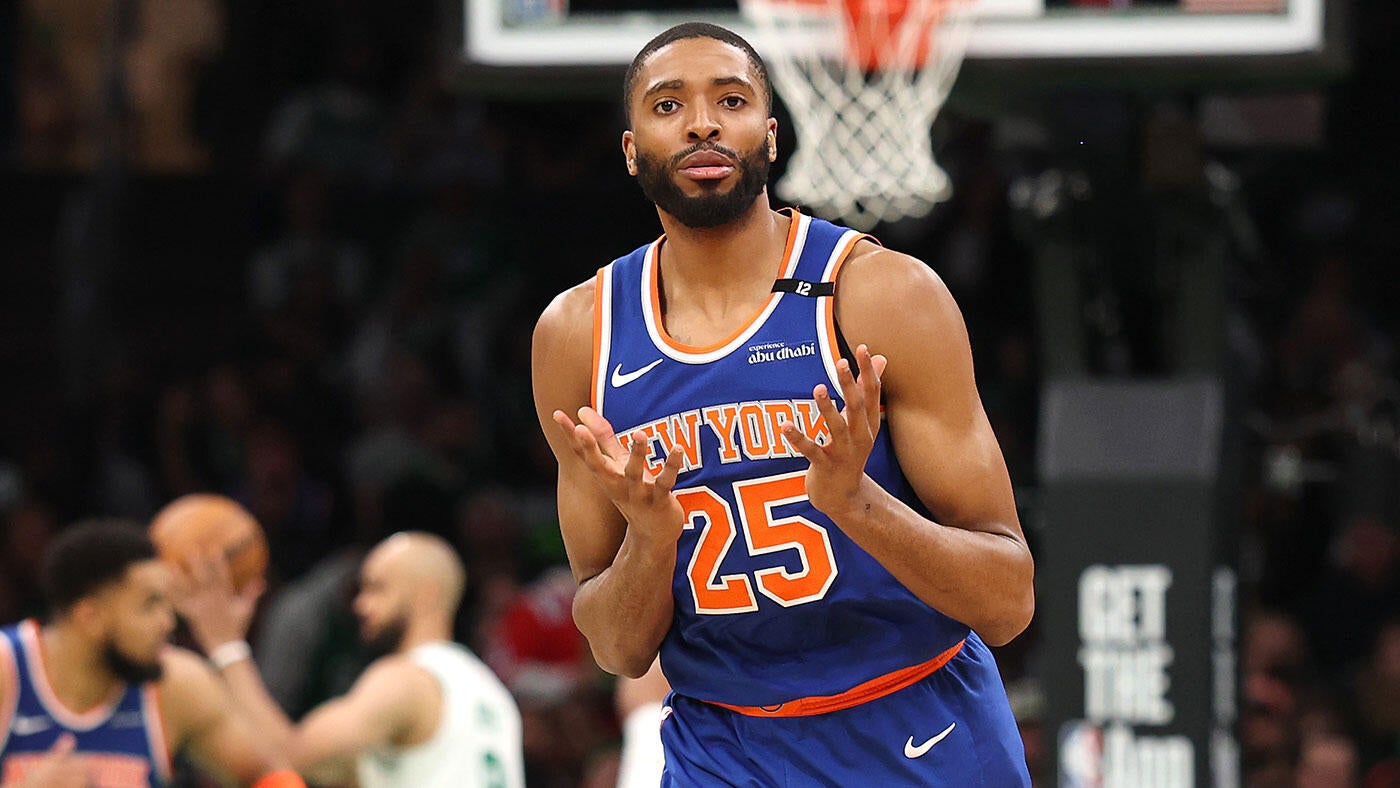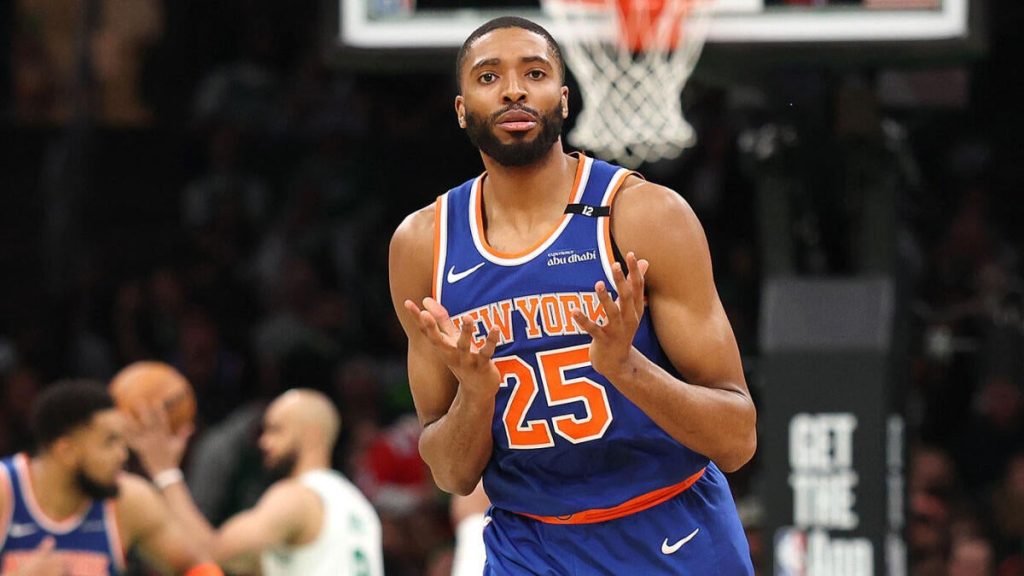
Mikal Bridges has agreed to a four-year, $150 million contract extension with the New York Knicks. The deal, reported Thursday by ESPN, has seemingly been in the works for more than a year after the Knicks acquired Bridges last offseason in a blockbuster trade with the Brooklyn Nets.
Soon after acquiring Bridges, the Knicks agreed to a long-term contract extension with cornerstone point guard Jalen Brunson, a team-friendly deal that came in well below market value. The expectation ever since was that Bridges, a Brunson teammate at Villanova, would follow suit — all in an effort to help keep together for the long haul a championship-contending roster New York has built over the last couple seasons.
With Bridges locked up, all five of the Knicks’ regular-season starters from a year ago — when they advanced to their first Eastern Conference Finals in 25 years — are locked up for at least the next two seasons (with another option year on top of that).
While the cost of securing those players has been steep, Bridges and the Knicks made meaningful concessions to get this deal across the finish line. So, what does the Bridges extension mean for New York both in the short and long term?
Here comes the second apron …
The Knicks have managed their finances about as intentionally as any team in basketball. They have deftly managed to duck the second apron for the second straight season. However, the way their contracts were structured, it was always likely that New York would find the second apron for the 2026-27 and 2027-28 campaigns — assuming the front office decides to keep the team together.
Depending where the Knicks draft and whether Guerschon Yabusele picks up his player option, New York was looking at somewhere between $45 million to $55 million in room beneath the second apron. If Bridges starts his new deal at the highest possible salary, he’ll cost around $33.5 million for the 2026-27 season. However, the Knicks will only have nine players under contract, eight if Yabusele opts out. Mitchell Robinson is not among them. if Robinson is re-signed and the roster is filled out, New York should bolt far above the second apron.
This was always the plan, for which New York has been well prepared. With a core in place, the roster-building restrictions created by the second apron won’t affect them as much as a team that is still building. The harshest penalty the second apron can impose is dropping a future first-round pick down to No. 30. That happens when a team has spent three years above the second apron across a five-year span. However, given the way New York’s books are set up, the franchise is set up to essentially reset its roster after the 2027-28 season when Karl-Anthony Towns’ contract expires.
The likely plan is to go all-in on winning a championship over the next three seasons before ducking back down below the second apron afterward. Brides’ new contract contract sets the Knicks up to do exactly that. As New York has yet to agree to a new deal with Robinson, it will have an out (if one is ultimately deemed necessary). Should Robinson’s health proves untenable long term, the Knicks could let him go next summer in order to stay below the second apron, giving them additional flexibility to improve. (At that point, their 2033 first-round pick would become available for trade so long as they remain below the second apron.)
Either way, the Knicks are more or less set, roster-wise, in the foreseeable future. If they believe they have constructed a championship roster, they can go whole hog with it for the next three seasons. If not, they’re still set up to retain some degree of flexibility. Few teams manage their books as well as the Knick, and this contract fits right into their intended structure.
Bridges took less than the max
While Bridges does not have nearly the value Brunson would demand on an open market, their decisions were similar from a financial standpoint. Both Brunson and Bridges wee initially on contracts that paid them well below market value and only eligible for 40% raises in the first season of a new deal, as veteran extension limitations are based on prior salary. Extending early would have meant limiting their upside. If Brunson had waited until 2025 free agency, he almost certainly would have signed a five-year maximum contract starting at 30% of the salary cap. Instead, he took less. It’s highly unlikely Bridges would have commanded a 30% max as a 2026 free agent. Now, we’ll never know. He followed suit by extending early, doing so within that 40% raise parameter.
Except Bridges didn’t even take the most he was eligible for in an extension. If Bridges had extended at 40% with 8% annual raises baked in each ensuing year, as he was eligible to do, his extension would have totaled roughly $156.1 million. Taking $150 million is not nearly the discount that Brunson gave the Knicks, but it’s nevertheless helpful. Every dollar counts in apron world.
The discount wasn’t the only favor Bridges did the Knicks. He also provided them with a timing advantage. When a player gets a first-year raise of at least 20% or annual raises higher than 5%, as Bridges did in this extension, he is ineligible to be traded for six months. Big-name players will sometimes intentionally wait until deep into the summer when they extend under these terms specifically to prevent a trade. Lauri Markkanen did this last offseason, extending on Aug. 7, 2024, because the trade deadline was Feb. 6, 2025.
Bridges chose not to wait. He was eligible to extend as early as July 6. If he had waited until Aug. 6, he would have essentially created a one-year no-trade clause, as the forthcoming trade deadline is Feb. 5 2026. By signing on July 31, he will become trade eligible at the end of January, giving New York a few days before the deadline to move him if it so chooses.
Given the Knicks’ long-standing interest in Giannis Antetokounmpo, those days could become significant. If New York want to pursue him during the season using Bridges as a trade chip, now it will be able to do so.
The Knicks gave big concessions, too
Part of the reason Bridges was willing to provide the Knicks those few days of trade flexibility was that New York factored in a trade kicker. While the Knicks will be able to trade Bridges closer to the deadline, in exchange for that privilege, they’ve agreed to pay him a sizable bonus if he gets traded at any point during his contract. That makes sense in Bridges’ situation. He wanted to play for the Knicks, specifically, ever since he was in Brooklyn. He was willing to give them a bit of a discount, but if they ship him off to an undesirable team, he wants to recoup the money he left on the table. With the trade kicker, he will.
That wasn’t the only meaningful concession Bridges got out of the Knicks, however. He also locked up a player option for the 2029-30 season. New York has become a bit more willing to hand out player options lately, but it historically has not been the franchise’s preference.
Brunson has one because he not only took a steep discount but is clearly the franchise player; the Knicks really didn’t have leverage not to give him one. OG Anunoby and Guerschon Yabusele have player options, too, but they both had leverage signing as free agents. Typically, the Knicks go the other way. Few teams manage to convince as many players to sign deals with team options or non-guarantees as New York. Josh Hart has one on the end of his current deal.
That player option may be enormously valuable for Bridges. If he’s still an effective player in 2029, going into his age-33 season, he’ll be able to seek one last, big payday a year early without fear of declining by 2030. It’s impossible to know know what the market will look like four summers from now, but given the league’s desperate need for wings and the rising cap environment that currently exists, so long as Bridges remains healthy (he’s literally never missed an NBA game), he should be able to cash in when that time arrives.
The Knicks and Bridges each made real sacrifices to get this deal done. Given the season they had together, that decision makes sense from both sides.
Though New York reached the Eastern Conference Finals, Bridges was a slight disappointment individually If he had performed as expected, he likely could have commanded that full $156.1 million max and signed it later into August, which would have protected him from a midseason trade. Given his up-and-down season, a contract like this is an appropriate middle ground. Perhaps the Knicks could have gotten him to give up a bit more money if they had delayed the signing. Perhaps Bridges could have gotten the full max without the player option. Instead, the agreement is basically the dictionary definition of a compromise.


